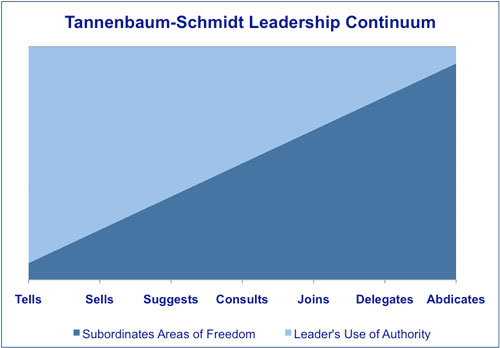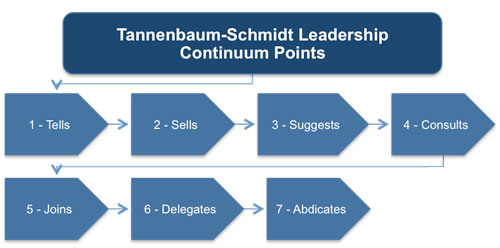Tannenbaum-Schmidt Leadership Continuum
Many leadership models and theories like to lump leadership strategies into just two or three categories and analyze them from there. While this can be helpful to get a general picture of how leadership works and what styles work under which circumstances, real life is usually more complicated than that. For this reason, a continuum makes a lot of sense because it covers a wider range of actual leadership approaches.
The Tannenbaum-Schmidt Leadership Continuum is a great example of this line of thinking. The continuum runs the spectrum of potential styles, and leaves plenty of leeway to land somewhere in the middle of the spectrum. Rare is the leader who will find themselves completely on one end of the equation or the other - nearly everyone will fall somewhere in the middle depending on their experience, personality, and the tasks that they are leading.
 |
From One Extreme to the Other
Before getting into the details of the points along the continuum, it is important to understand the extremes that mark each end. On one end of the spectrum, we find Manager-oriented Leadership. This means that the leader acts mostly like a dictator, telling the team members what to do and leaving very little (or no) room for negotiation. Most commonly, this is a strategy employed by leaders who are dealing with an inexperienced team, or a tight deadline that they have to meet. However, even the most strict leader will typically leave at least a little room for discussion and collaboration.
At the other end is what is called Team-oriented Leadership. As you might imagine, this is a leader who provide his or her team with plenty of flexibility and encourages collaboration and the sharing of ideas. Usually, this sort of latitude will only be afforded to a team that has a high level of experience and acumen in a given area. This kind of leader must have a great deal of trust in their team in order to trust them with such freedom.
Within those extremes, the Tannenbaum-Schmidt Leadership Continuum highlights seven points along the way which can be used to describe various leadership styles. Following is a quick discussion of each of those seven categories.
Tells
This style is very close to the extreme, as the team is given direct instructions and the interaction between the leader and the team members is very limited. Most of the time, a leader will use this style when they lack the trust that comes with experience in working with a team. As time passes and a team works together more and more, the leader will usually evolve away from this direct management method.
Sells
Sliding a bit up the scale, this point is marked by leadership which is still direct, but also allows for a little bit of back and forth between the leader and the team. In the end, it is the leader that will be calling the shots, but at least the team is provided with the opportunity to give some input and have their voice be heard.
Suggests
When a leader using a suggesting style, they are softer in their approach to the team and want to make sure that the team feels like they have real, valued input in the process. How much that input is actually taken into consideration will depend on the level of experience among the team, and how much trust the leader has in them at this point. However, this style can go a long way toward growing the experience of the team as it allows them a little more insight into the process than the previous two styles on the list.
 |
Consults
As the name would indicate, this style of leadership is increasingly collaborative between the leader and the team. A leader is only going to feel comfortable moving to this position on the continuum when they are sure that the team members are experienced enough to put trust in their thinking and decision making. This style goes beyond 'superficial' interaction with the team and actually gives them power over how the process is going to be dealt with. While consulting requires a team with experience and skill, it is a great way to keep all of the members of the team engaged in the process.
Joins
At this point along the line, the leader starts to become more a member of the team than a dictator who is telling everyone what to do. While the leader retains the power in the situation and will be the one responsible for making choices in the end, the team is genuinely used to help make decisions. This kind of leadership is usually the choice of someone who is leading an experienced team made up of individuals who have highly developed skills in their specifics areas of expertise.
Delegates
Moving closer to the other extreme, the leader who delegates is one who has a high degree of trust in his or her team. Rather than becoming a part of the team, the leader steps back from the team and trusts them to get the job done. Usually, there will be parameters put in place to make sure the team stays on track and is working toward the right goal, but the leader isn't necessarily involved in the day to day decision making process.
Abdicates
The Abdicates style of leadership is the end of the spectrum, and represents a point where the leader essentially relinquishes any involvement and trust the team to get the job done from start to finish. Basically, the only connection the leader has to the team is bearing responsibility for the work that they do, so obviously trust and experience are going to be essential to success at this far end of the leadership continuum.
Using the Tannenbaum-Schmidt Leadership Continuum is an excellent way to understand the various approaches that leaders can take to managing their teams. Since it is more nuanced than many other leadership theories, a wider variety of leaders will find this tool to be a useful one. As you prepare to lead a new team, or work on improving the performance of your current team, consider the various styles represented within this model.
You may also be interested in:
Action Centered Leadership | Blake-Mouton Managerial Grid | Dunham and Pierce's Leadership Process Model | Fiedler's Contingency Model | French and Raven's Five Forms of Power | Hersey-Blanchard Situational Leadership Theory | Tannenbaum-Schmidt Leadership Continuum | Lewin's Leadership Styles Framework | Path-Goal Theory | Zenger and Folkman's 10 Fatal Leadership Flaws.



